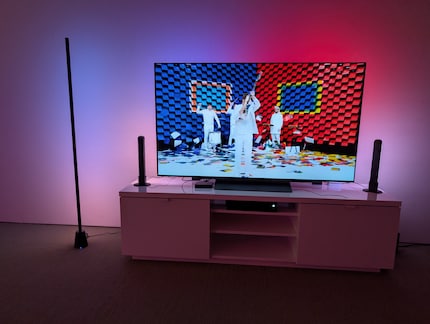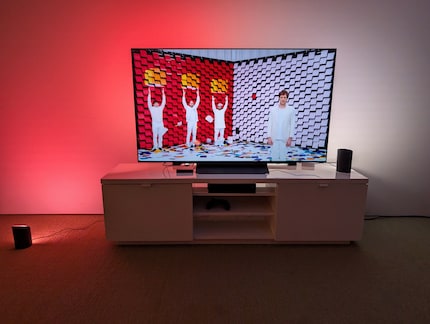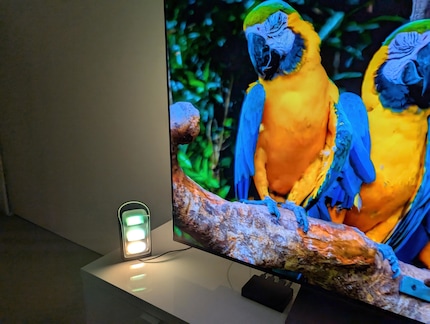
Guide
Let there be light – tips for getting started in the world of Hue
by Martin Jungfer

Sister brands Philips Hue and Wiz both sell sync boxes and smart lights for TVs. But is price the only difference between the systems?
These colourful living room lights are a kind of gateway drug to the world of smart lamps. After initially buying a set for their TV, many go on to gradually revamp their entire lighting setup. With Wiz and Philips Hue, Dutch manufacturer Signify offers two systems that differ on more than just price.
I pitted the entry-level lighting sets against each other at Signify’s Hamburg branch.
The Wiz box costs a mere 70 francs or euros for TVs measuring 55 to 65 inches, or 90 francs for larger screens. This price difference is down to the fact that longer light strips are needed for bigger TVs. On the back of the TV, LED strips are attached to the top and sides, lighting up the wall behind.
The Sync Box hooks up to your TV box and TV via HDMI cable. Its job is to analyse image signals in real time, then convert them into suitable lighting scenes. If there’s a green meadow on the TV, the light strip will also turn green. If multiple colours appear on screen, the lighting will be adjusted accordingly, as if the TV picture’s being projected onto the wall.
It works particularly well with music videos, games, cartoons and animated films, which often contain strong colours and contrasts. You can adjust the brightness and intensity to your preferred level in the app. However, if it’s a dark horror film you’re watching, a light strip obviously won’t be as much use to you.
In this example, we placed two Gradient Light Bars from Wiz on either side of the TV. These illuminate walls from below, intensifying the effect over a larger area. A set of two will set you back about 50 francs or euros.
In principle, all Wiz lights connected to the same Wi-Fi network can be controlled via the Sync Box. Conversely, you can also use the LEDs on and around the TV as everyday lighting. This involves switching on preset lighting modes or using the app to adjust colours and intensity down to the smallest detail.
Philips Hue is Signify’s second smart lighting system. The two systems aren’t compatible with each other and they’re aimed at different customers. While Wiz is simple and affordable, Philips Hue relies on a complex system encompassing hundreds of lamps, lights and accessories.
The matching two-pack of lamps for lighting up the wall is also significantly pricier at around 95 francs or euros.
We chose an even more elegant version for our comparison setup: the Philips Hue Play wall washer. At 350 francs or euros for the pair, the lights cost a pretty penny. Mind you, they’re genuinely stylish, so you can keep them on your TV stand as an eye-catching piece of decor.
Incidentally, Philips now offers a way of replacing the Sync Box. The Hue Sync TV app can be downloaded onto LG and Samsung TVs. It converts on-screen content into light, removing the need for a separate box. At a one-off price of 130 francs or euros (or three francs or euros for a monthly subscription), the app isn’t exactly a bargain.
Price-wise, Wiz beats its rival Signify subsidiary hands down. If you don’t fancy shelling out a lot of cash, there are around 200 compatible Wiz devices, from lamps to bulbs, lights, switches and security cameras.
As for Philips Hue, we stock over 300 of the brand’s products in our range. Hue’s strength lies in its variety and knack for design, with many of the products being more sophisticated and higher quality. The brand also has a more extensive range of security and outdoor products than Wiz does.
If you compare the way the lights synchronise with the TV, the differences are minimal. Hue reflects more of the finer details, but I only notice that when I use both systems at once.
Deciding to go for one of Signify’s brands over the other is a question of both budget and the strength of that gateway drug effect. If you want to gradually kit out your entire house and garden with smart lighting – and if it’s important to you that the lamps look pretty – you’re more likely to choose a Hue system. If you’re happy enough with something basic or only want to rig individual areas of your home with lights, then Wiz will be in pole position.
Gadgets are my passion - whether you need them for the home office, for the household, for sport and pleasure or for the smart home. Or, of course, for the big hobby next to the family, namely fishing.
Practical solutions for everyday problems with technology, household hacks and much more.
Show all

A classic example of this is the Sync Box, which is also available from Hue. Priced at over 260 francs or euros, it’s more expensive than the Wiz version. However, it also supports 8K TVs and has four HDMI inputs for game consoles, Blu-ray players or streaming boxes. With a Wiz system, you’ll have to make do with a 4K TV and an HDMI socket. The light strip, which you fix to the back of your TV, costs extra. Depending on the length, you’ll have to fork out between 150 and 190 francs or euros.
